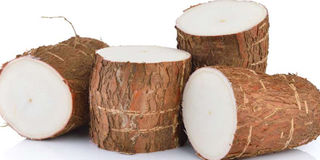Resistant cassava from Tanzania the key to bumper harvests

Isolation of viral diseases that constrain successful cassava production raises hope for higher yields for farmers in east, central and southern Africa. PHOTO| FILE| NATION MEDIA GROUP
Scientists have succeeded in isolating the first-ever genetic markers associated with two cassava varieties’ resistance to two lethal viral diseases affecting the crop.
The Namikonga and Albert cassava varieties typically cultivated by farmers in Tanzania have for a long time shown resistance and ability to withstand cassava brown streak disease (CBSD) and cassava mosaic disease (CMD) respectively, which other varieties cannot.
While the Namikonga variety shows resistance to CBSD and susceptibility to CMD, the Albert variety shows resistance to CMD and susceptibility to CBSD.
SPEED UP LONG AND EXPENSIVE CONVENTIONAL BREEDING
The two genetically related cassava varieties have been cultivated by farmers in areas prone to the two viral diseases for many years, displaying high tolerance despite being subjected to the adversity of the diseases over time.
The scientists who had been studying the phenomenon have thus effectively established the genetic markers linked to the resistance of the two varieties to each of the viral diseases.
These findings will be used to speed up the usually long and expensive conventional breeding of cassava varieties with dual resistance to the diseases.
The international team of scientists, drawing membership from Kenya, Tanzania, South Africa, and the United States, crossed the two cassava varieties and studied a large population of the progeny over two seasons in two disease hotspots, where they detected the main resistance to CBSD on chromosomes 2 and 11, and resistance to CMD on chromosome 12, with several other genomic regions in different chromosomes having minimal influence on the envisioned resistance.
The team published their findings in the journal Theoretical and Applied Genetics: International Journal of Plant Breeding Research.
MARKER-ASSISTED SELECTION
“These studies have enabled us understand the location of genes we believe are associated with resistance to CBSD in the DNA of Namikonga, and CMD in the Albert cassava variety, and once validated, this will help in speeding up breeding through marker-assisted selection which shortens the breeding cycle and reduces the offspring population that breeders have to work with,” said Esther Masumba, a molecular breeder from the Tanzanian Ministry of Agriculture, Livestock and Fisheries, who was part of the research team.
“Breeders will thus be able to quickly narrow down from the thousands of offspring to only those with the desired markers and the application of these molecular markers in breeding and selection of crop varieties will reduce both breeding time and costs,” she added.
“Where there is a greater fear of the diseases spreading and causing distressing effects on food security, the markers can assist in pre-emptive breeding,” said Morag Ferguson a molecular breeder from the International Institute of Topical Agriculture (IITA) who was also part of the research team. The team will continue to authenticate these markers for applicability in marker assisted breeding.
CMD and CBSD are among the biggest constraints to successful cassava production in East, Central and Southern Africa where the crop is a major source of both food and income for many small-holder farmers.
Nearly all varieties grown by farmers in the region are susceptible to either or both the two diseases, significantly reducing farming communities’ cassava yields.
The Namikonga variety is a result of efforts to control the diseases in East Africa, which were initiated in the early 1930s at the East African Cassava Research Institute in Amani, in north-eastern Tanzania, by crossing several wild cassava species to develop hybrids.
The breed, which alongside Albert, is genetically related to a West African cassava variety called TME117, and has been adopted by local farmers.


